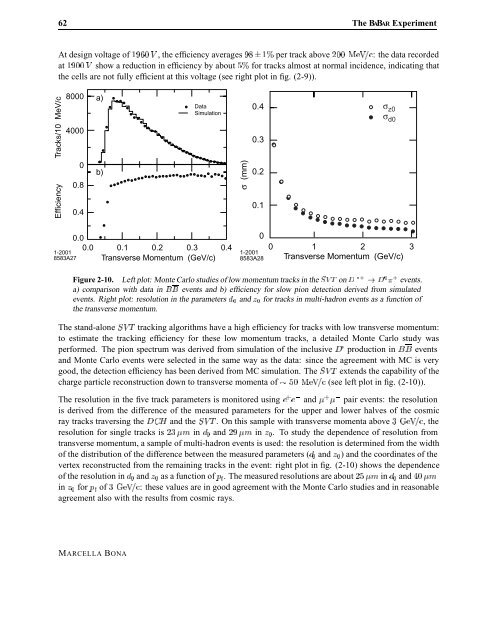Violation in Mixing
Violation in Mixing
Violation in Mixing
You also want an ePaper? Increase the reach of your titles
YUMPU automatically turns print PDFs into web optimized ePapers that Google loves.
62 The BABAR Experiment<br />
At design voltage of �� Î , the efficiency averages ��¦ per track above Å�Î� : the data recorded<br />
at � Î show a reduction <strong>in</strong> efficiency by about � for tracks almost at normal <strong>in</strong>cidence, <strong>in</strong>dicat<strong>in</strong>g that<br />
the cells are not fully efficient at this voltage (see right plot <strong>in</strong> fig. (2-9)).<br />
Tracks/10 MeV/c<br />
Efficiency<br />
8000<br />
4000<br />
1-2001<br />
8583A27<br />
0<br />
0.8<br />
0.4<br />
a)<br />
b)<br />
Data<br />
Simulation<br />
0.0<br />
0.0 0.1 0.2 0.3 0.4<br />
Transverse Momentum (GeV/c)<br />
σ (mm)<br />
0.4<br />
0.3<br />
0.2<br />
0.1<br />
1-2001<br />
8583A28<br />
σ z0<br />
σ d0<br />
0<br />
0 1 2<br />
3<br />
Transverse Momentum (GeV/c)<br />
Figure 2-10. Left plot: Monte Carlo studies of low momentum tracks <strong>in</strong> the ËÎÌ on � £ � � � events.<br />
a) comparison with data <strong>in</strong> �� events and b) efficiency for slow pion detection derived from simulated<br />
events. Right plot: resolution <strong>in</strong> the parameters � and Þ for tracks <strong>in</strong> multi-hadron events as a function of<br />
the transverse momentum.<br />
The stand-alone ËÎÌ track<strong>in</strong>g algorithms have a high efficiency for tracks with low transverse momentum:<br />
to estimate the track<strong>in</strong>g efficiency for these low momentum tracks, a detailed Monte Carlo study was<br />
performed. The pion spectrum was derived from simulation of the <strong>in</strong>clusive � £ production <strong>in</strong> �� events<br />
and Monte Carlo events were selected <strong>in</strong> the same way as the data: s<strong>in</strong>ce the agreement with MC is very<br />
good, the detection efficiency has been derived from MC simulation. The ËÎÌ extends the capability of the<br />
charge particle reconstruction down to transverse momenta of � � �� (see left plot <strong>in</strong> fig. (2-10)).<br />
The resolution <strong>in</strong> the five track parameters is monitored us<strong>in</strong>g � � and � � pair events: the resolution<br />
is derived from the difference of the measured parameters for the upper and lower halves of the cosmic<br />
ray tracks travers<strong>in</strong>g the ��À and the ËÎÌ. On this sample with transverse momenta above ��Î�, the<br />
resolution for s<strong>in</strong>gle tracks is �Ñ <strong>in</strong> � and � �Ñ <strong>in</strong> Þ . To study the dependence of resolution from<br />
transverse momentum, a sample of multi-hadron events is used: the resolution is determ<strong>in</strong>ed from the width<br />
of the distribution of the difference between the measured parameters (� and Þ ) and the coord<strong>in</strong>ates of the<br />
vertex reconstructed from the rema<strong>in</strong><strong>in</strong>g tracks <strong>in</strong> the event: right plot <strong>in</strong> fig. (2-10) shows the dependence<br />
of the resolution <strong>in</strong> � and Þ as a function of ÔØ. The measured resolutions are about � �Ñ <strong>in</strong> � and � �Ñ<br />
<strong>in</strong> Þ for ÔØ of ��Î�: these values are <strong>in</strong> good agreement with the Monte Carlo studies and <strong>in</strong> reasonable<br />
agreement also with the results from cosmic rays.<br />
MARCELLA BONA















